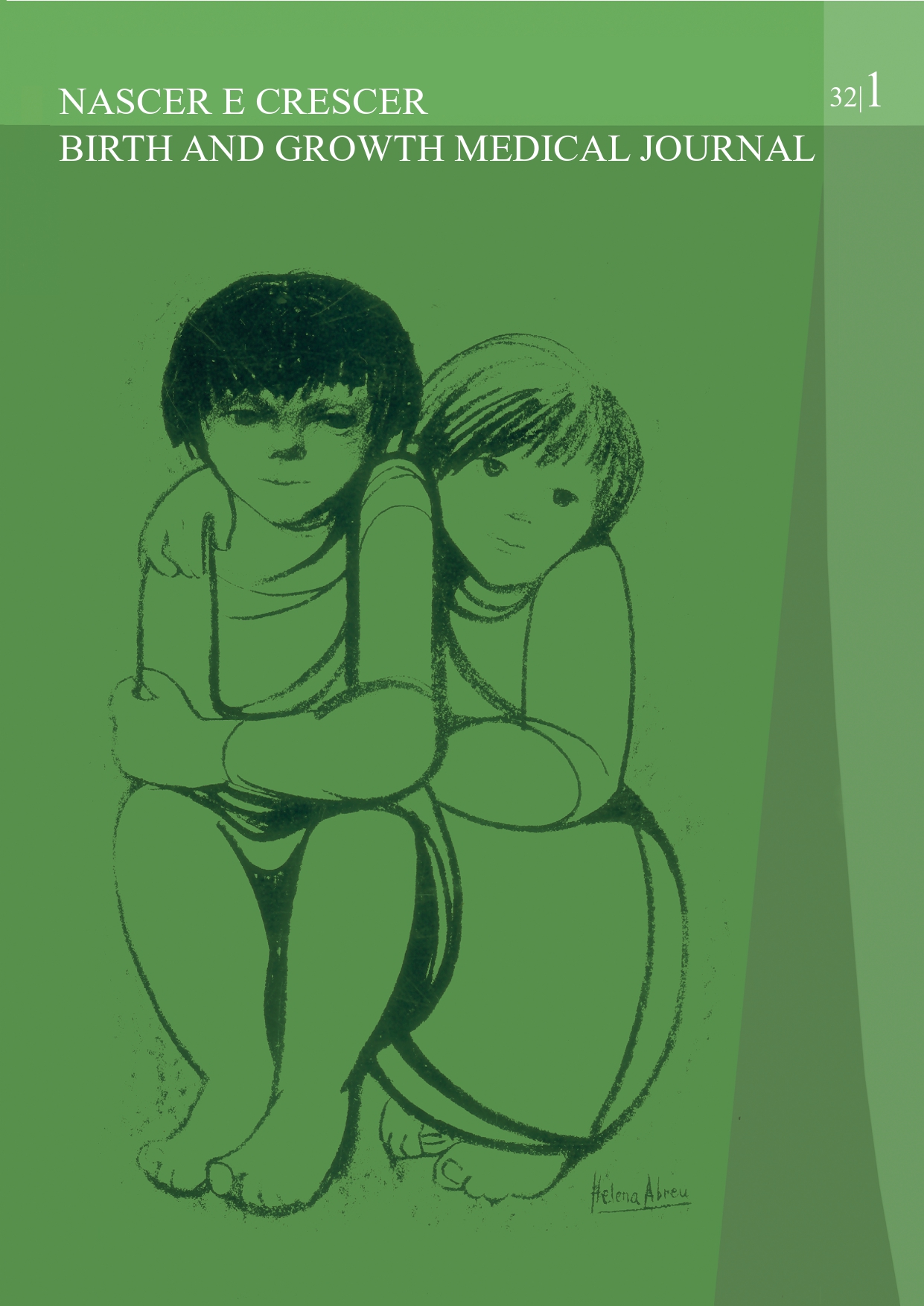Fatores relacionados com função residual das células β na diabetes mellitus tipo 1 inaugural
DOI:
https://doi.org/10.25753/BirthGrowthMJ.v32.i1.26262Palavras-chave:
célula β, diabetes mellitus tipo 1, peptídeo CResumo
Objetivos: Identificar fatores relacionados com os níveis de peptídeo C ao diagnóstico de diabetes mellitus tipo 1 (DM1).
Material e Métodos: Revisão retrospetiva dos processos clínicos de doentes diagnosticados com DM1 entre agosto de 2010 e julho de 2019 num centro de referência português.
Resultados: O estudo incluiu 109 participantes, com idade média de 8.6 anos e 29.4% púberes. O z-score médio do índice de massa corporal (IMC) foi 0.09. O nível de peptídeo C em jejum mediano foi 0.46 ng/mL e a hemoglobina A1C (HbA1C) mediana foi 10.85%. Vinte e dois por cento dos casos apresentaram-se com cetoacidose diabética.
Foi observada uma correlação positiva significativa entre o nível de peptídeo C e a idade (p<0.001) e o nível de peptídeo C e o z-score do IMC (p=0.041). Foram detetados níveis mais elevados de peptídeo C em crianças com excesso de peso/obesidade (p=0.008) e púberes (p<0.001). Os níveis de peptídeo C correlacionaram-se positivamente com os níveis séricos de bicarbonato (p=0.005), mas não com o pH venoso, HbA1C ou duração dos sintomas anteriores. Não foram registadas diferenças estatisticamente significativas nos níveis de peptídeo C em jejum em função do sexo, autoanticorpos para a DM1, história familiar de DM1 e sazonalidade.
Conclusão: Os doentes mais velhos, púberes e com excesso de peso/obesidade apresentaram níveis mais elevados de peptídeo C ao diagnóstico. Em contexto agudo, o bicarbonato sérico foi o parâmetro bioquímico que melhor se correlacionou com a função residual das células β.
Downloads
Referências
Ehlers MR. Immune interventions to preserve beta cell function in type 1 diabetes. Journal of investigative medicine: the official publication of the American Federation for Clinical Research. 2016;64(1):7-13.
Couper JJ, Haller MJ, Greenbaum CJ, Ziegler AG, Wherrett DK, Knip M, et al. ISPAD Clinical Practice Consensus Guidelines 2018: Stages of type 1 diabetes in children and adolescents. Pediatric diabetes. 2018;19 Suppl 27:20-7.
Keenan HA, Sun JK, Levine J, Doria A, Aiello LP, Eisenbarth G, et al. Residual insulin production and pancreatic ss-cell turnover after 50 years of diabetes: Joslin Medalist Study. Diabetes. 2010;59(11):2846-53.
Hwang JW, Kim MS, Lee DY. Factors Associated with C-peptide Levels after Diagnosis in Children with Type 1 Diabetes Mellitus. Chonnam medical journal. 2017;53(3):216-22.
Leighton E, Sainsbury CA, Jones GC. A Practical Review of C-Peptide Testing in Diabetes. Diabetes therapy : research, treatment and education of diabetes and related disorders. 2017;8(3):475-87.
Wolfsdorf JI, Glaser N, Agus M, Fritsch M, Hanas R, Rewers A, et al. ISPAD Clinical Practice Consensus Guidelines 2018: Diabetic ketoacidosis and the hyperglycemic hyperosmolar state. Pediatric diabetes. 2018;19 Suppl 27:155-77.
Szypowska A, Groele L, Wysocka-Mincewicz M, Mazur A, Lisowicz L, Ben-Skowronek I, et al. Factors associated with preservation of C-peptide levels at the diagnosis of type 1 diabetes. Journal of diabetes and its complications. 2018;32(6):570-4.
Yu HW, Lee YJ, Cho WI, Lee YA, Shin CH, Yang SW. Preserved C-peptide levels in overweight or obese compared with underweight children upon diagnosis of type 1 diabetes mellitus. Ann Pediatr Endocrinol Metab. 2015;20(2):92-7.
Leete P, Mallone R, Richardson SJ, Sosenko JM, Redondo MJ, Evans-Molina C. The Effect of Age on the Progression and Severity of Type 1 Diabetes: Potential Effects on Disease Mechanisms. Current diabetes reports. 2018;18(11):115.
VanBuecken DE, Greenbaum CJ. Residual C-peptide in type 1 diabetes: what do we really know? Pediatric diabetes. 2014;15(2):84-90.
Kim S, Park M. Effects of growth hormone on glucose metabolism and insulin resistance in human. Ann Pediatr Endocrinol Metab. 2017:145–52.
Liu J, Bian L, Ji L, Chen Y, Chen H, Gu Y, et al. The heterogeneity of islet autoantibodies and the progression of islet failure in type 1 diabetic patients. Science China Life sciences. 2016;59(9):930-9.
Downloads
Publicado
Como Citar
Edição
Secção
Licença
Direitos de Autor (c) 2023 Vera Gonçalves, Liliana Teixeira, Joana Freitas, Maria João Oliveira, Teresa Borges

Este trabalho encontra-se publicado com a Creative Commons Atribuição-NãoComercial 4.0.
Copyright and access
This journal offers immediate free access to its content, following the principle that providing free scientific knowledge to the public provides greater global democratization of knowledge.
The works are licensed under a Creative Commons Attribution Non-commercial 4.0 International license.
Nascer e Crescer – Birth and Growth Medical Journal do not charge any submission or processing fee to the articles submitted.


